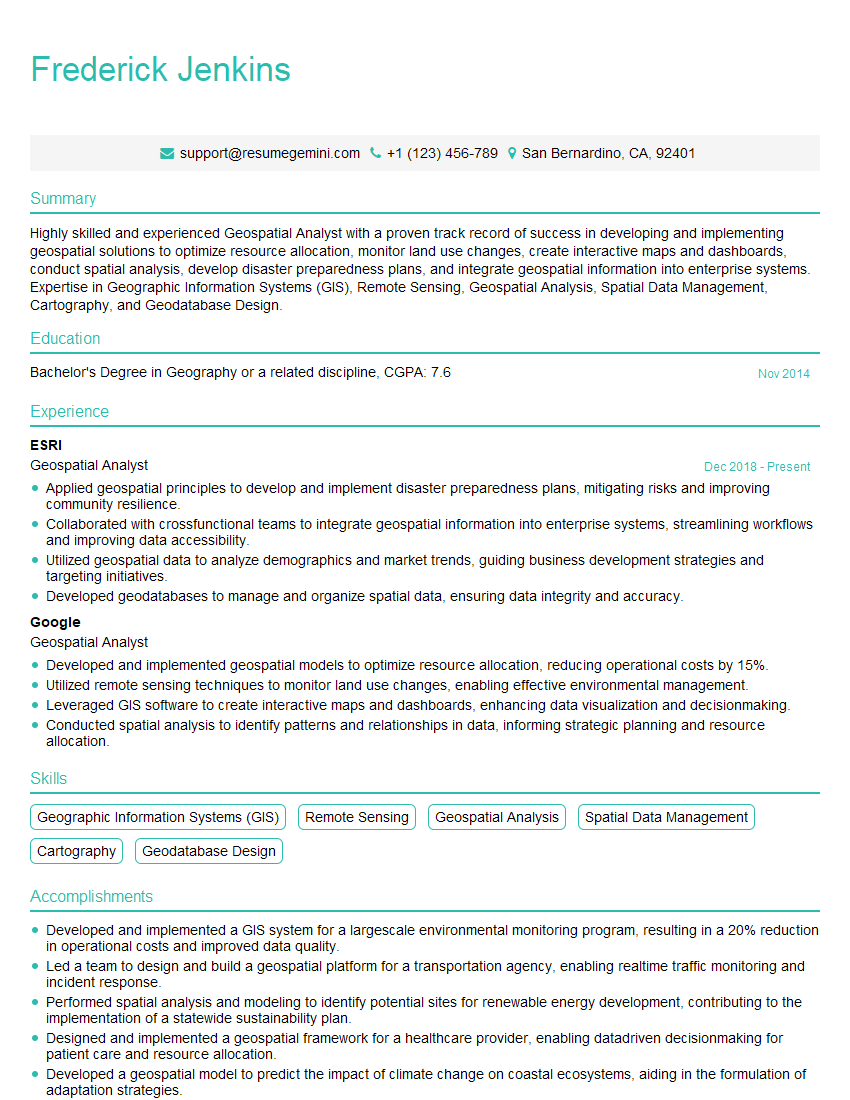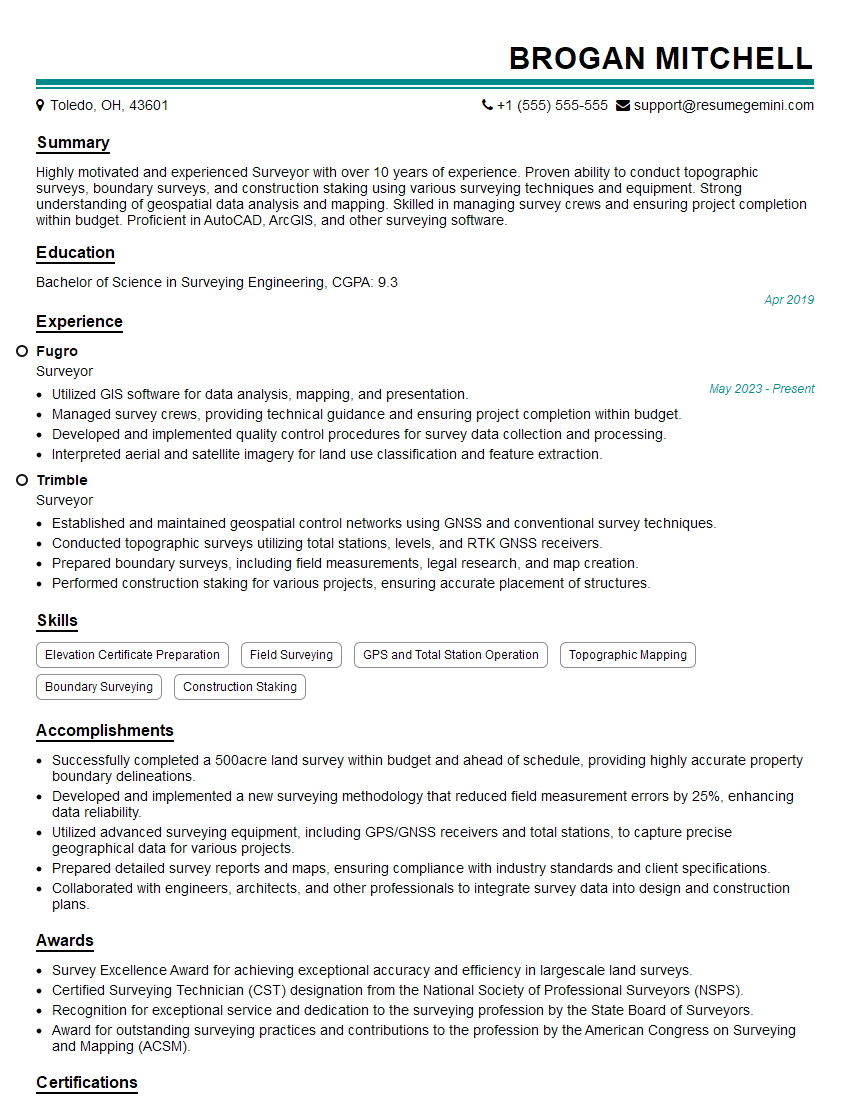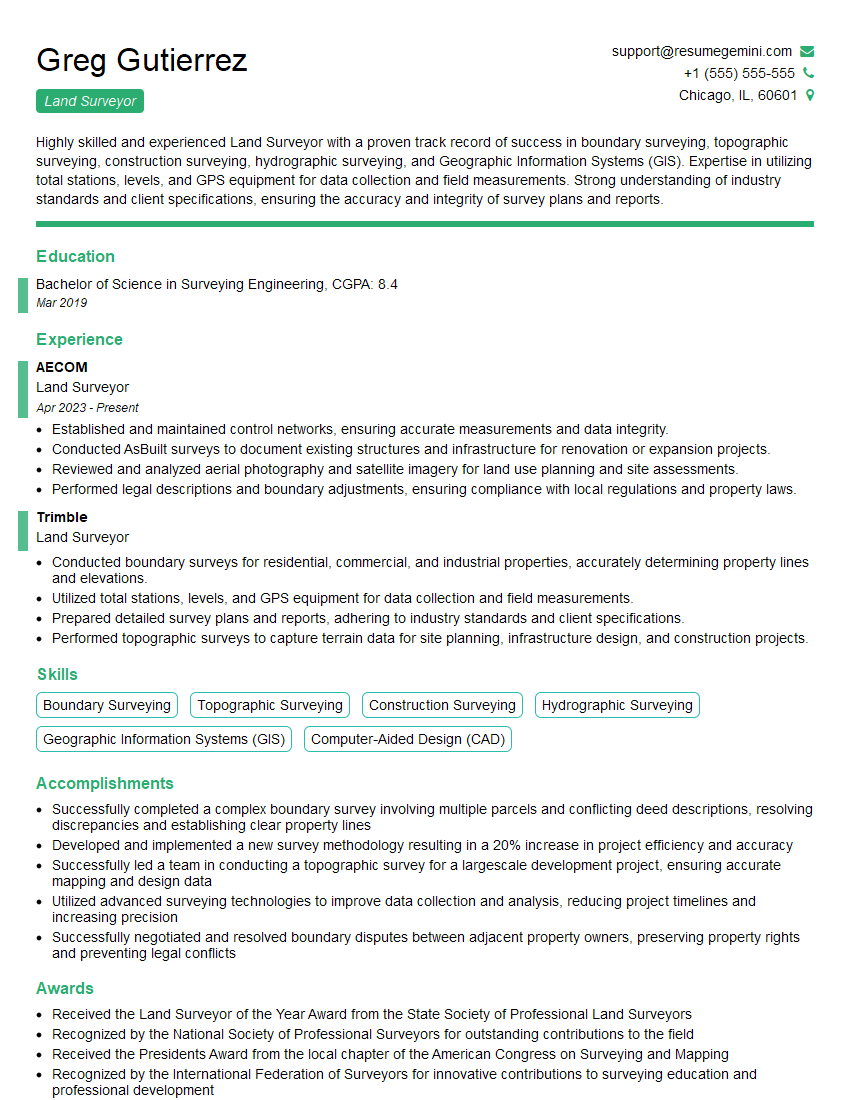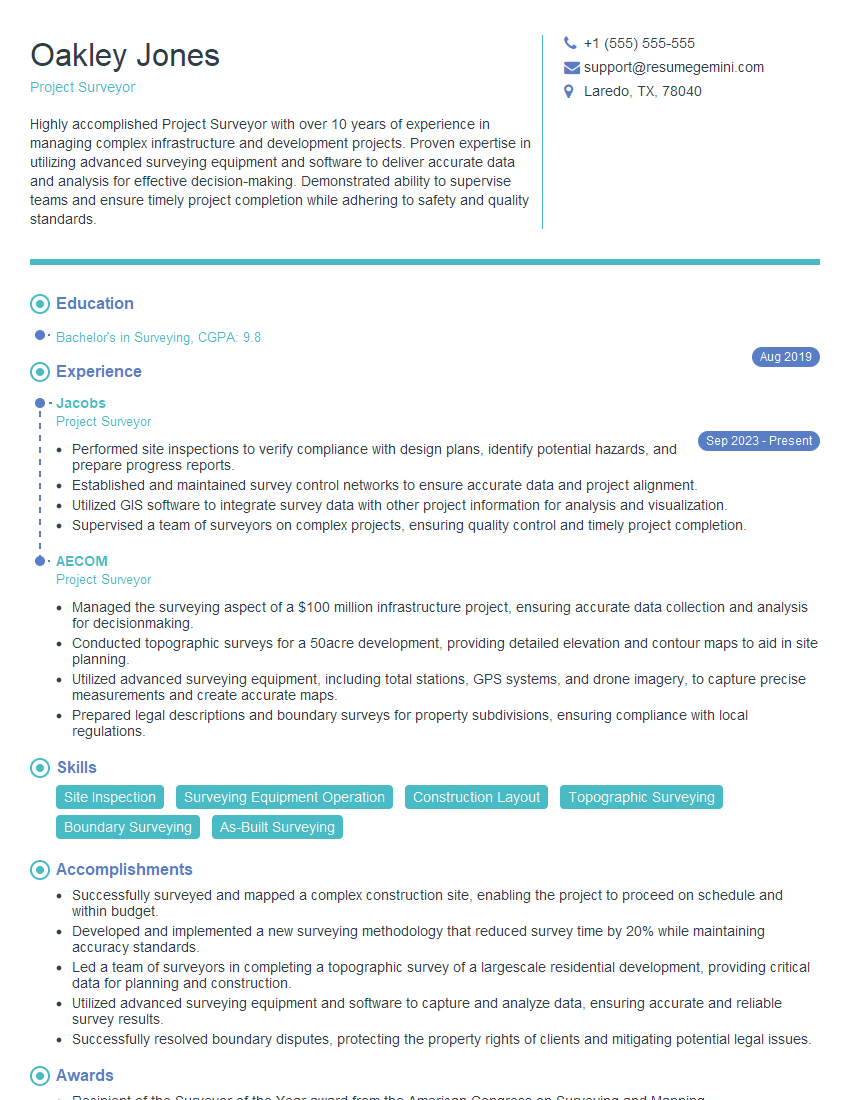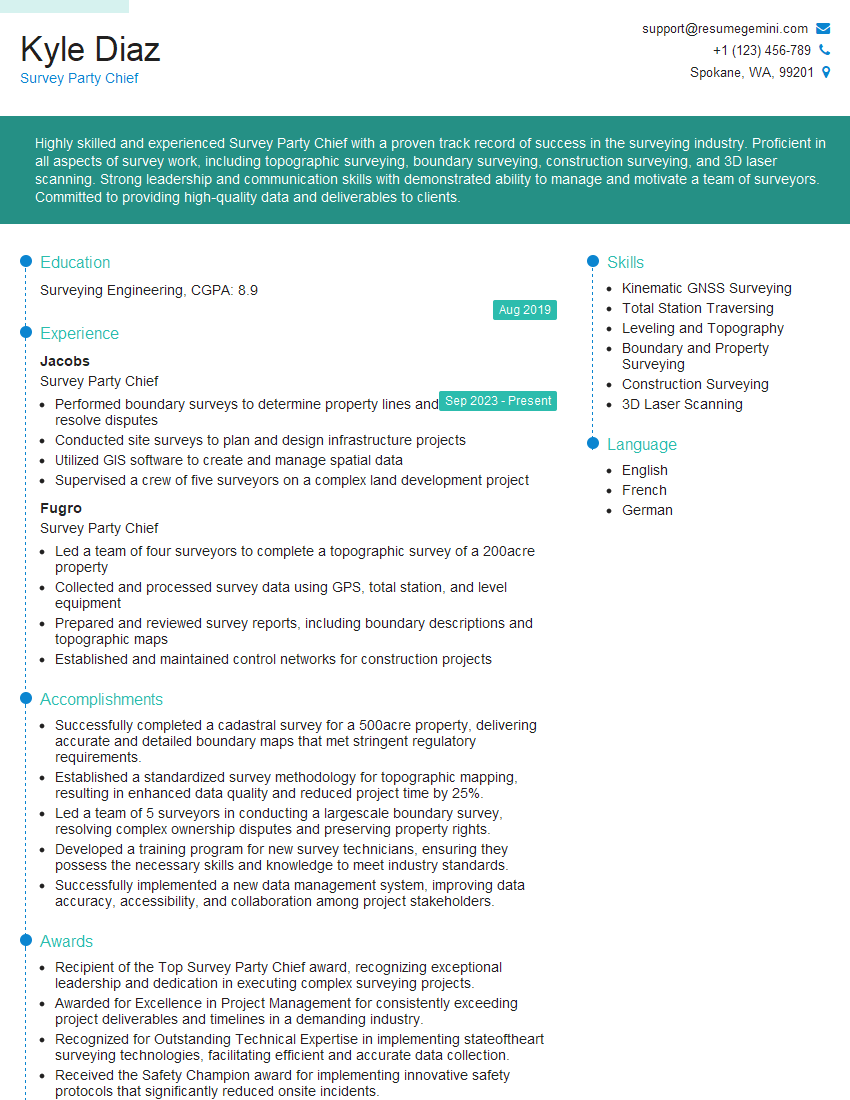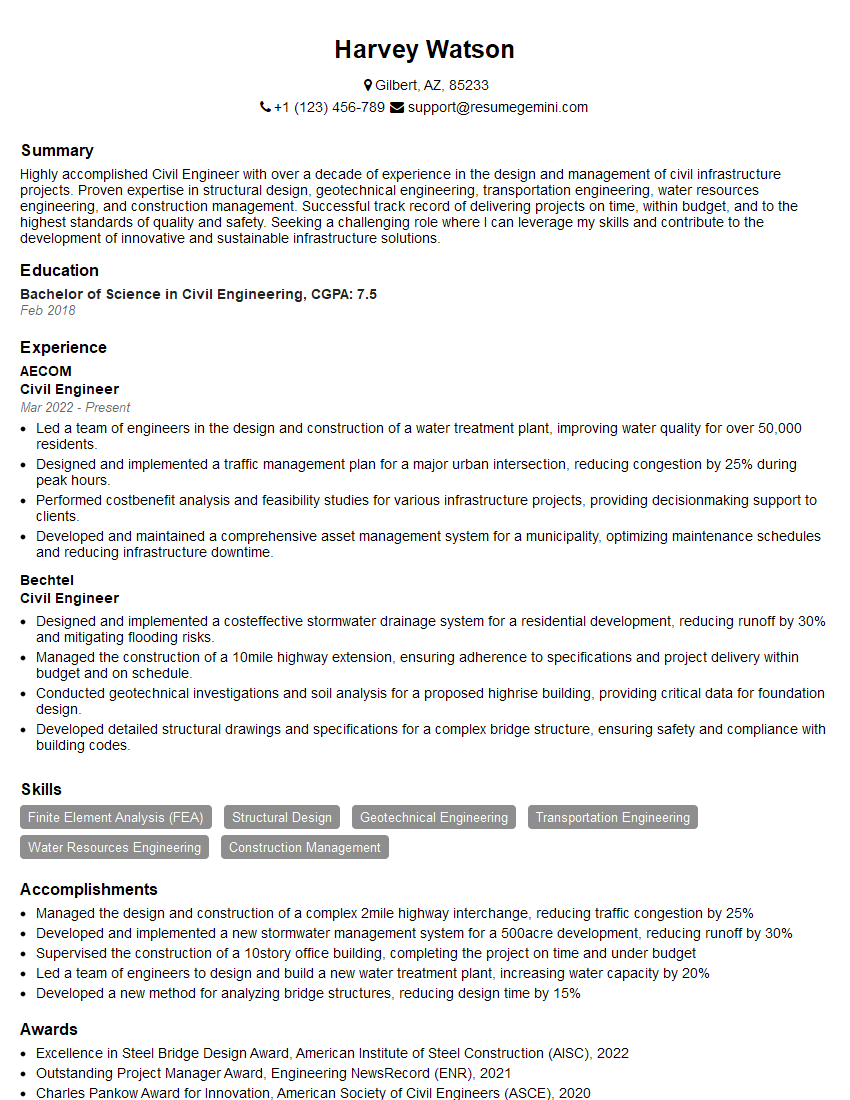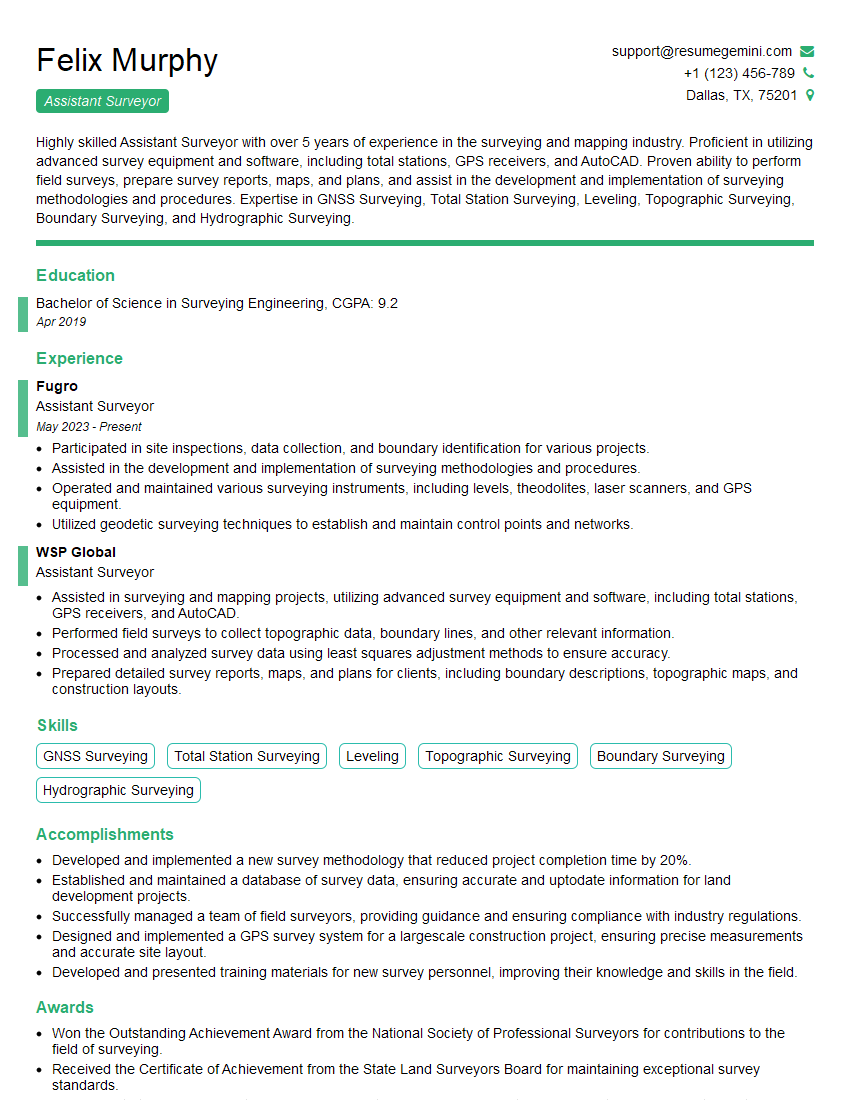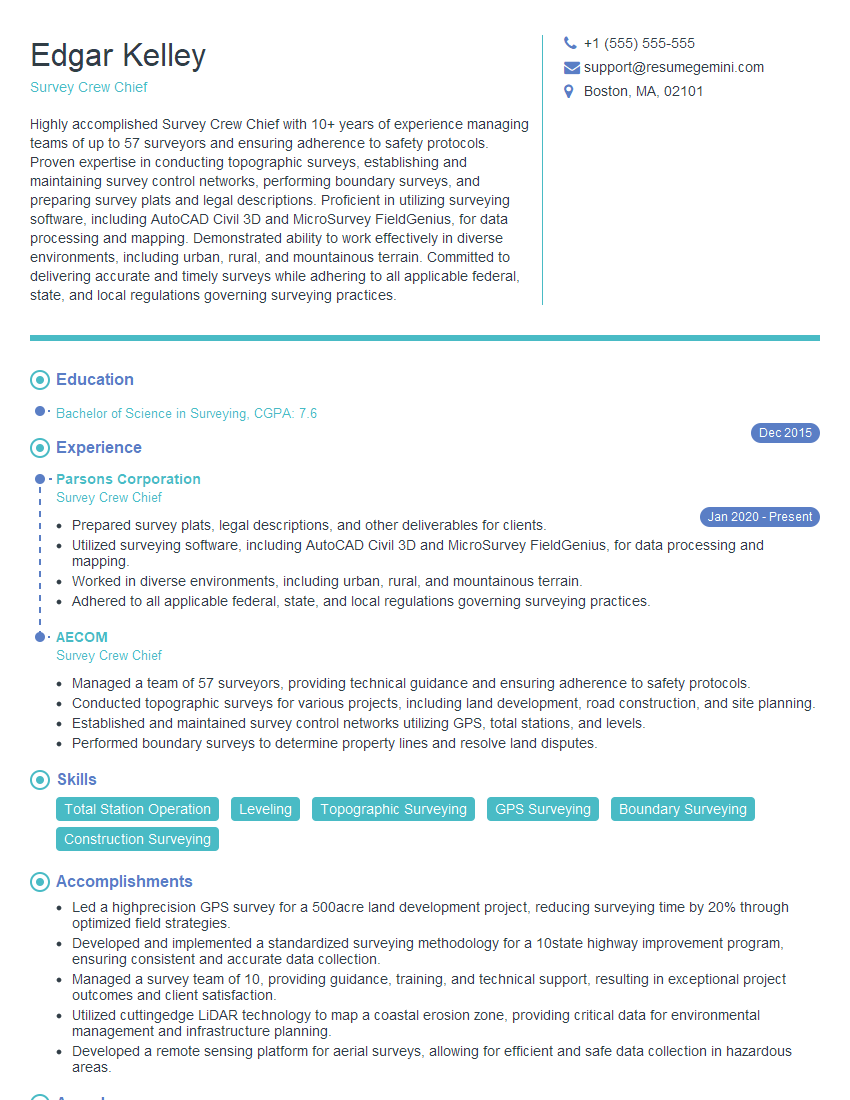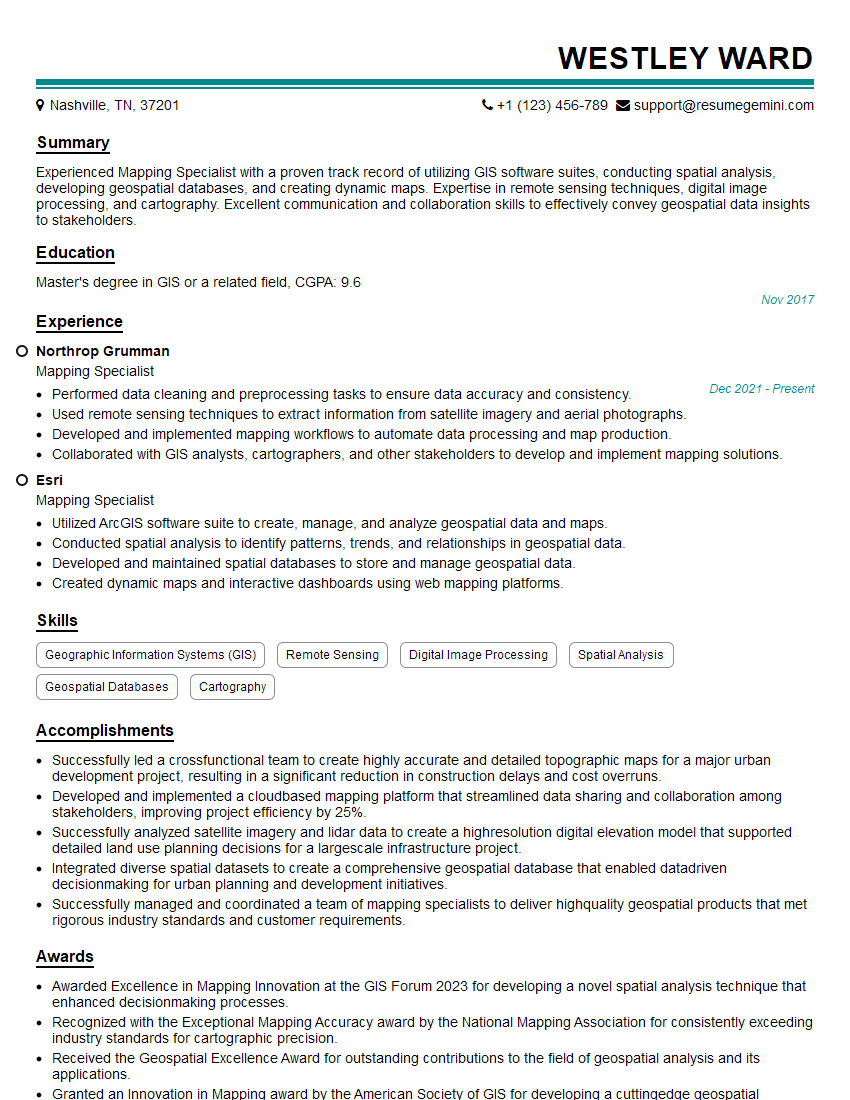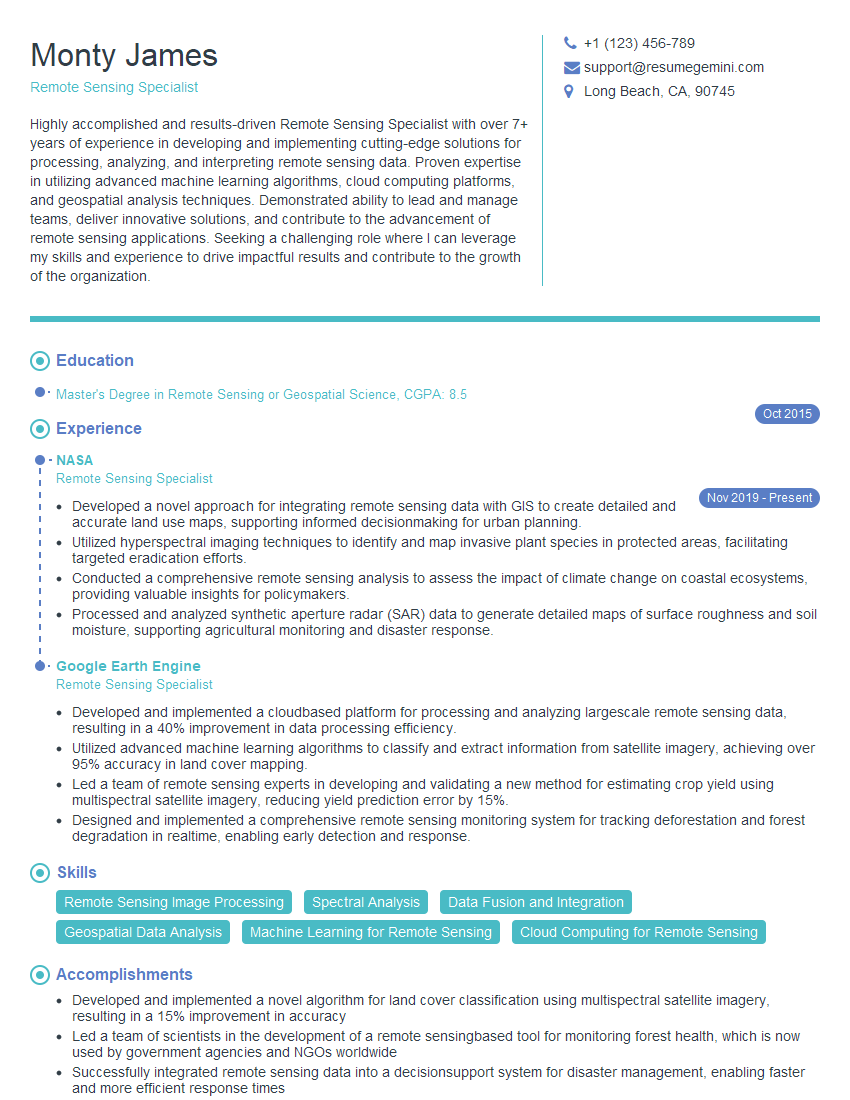The thought of an interview can be nerve-wracking, but the right preparation can make all the difference. Explore this comprehensive guide to Total Station Traversing interview questions and gain the confidence you need to showcase your abilities and secure the role.
Questions Asked in Total Station Traversing Interview
Q 1. Explain the principle of traversing using a Total Station.
Total Station traversing is a surveying technique used to establish a network of control points by measuring horizontal and vertical angles and distances between them. Imagine it like creating a detailed map by connecting a series of precisely located points. The principle relies on the precise measurement of angles and distances to calculate the coordinates of each point relative to a known starting point (a control point with known coordinates). This chain of measurements forms a traverse, allowing us to determine the precise location of all points within the network.
The process starts with a known point. From there, the total station measures the distance and angle to the next point. This process is repeated for each subsequent point in the traverse. Each point’s coordinates are then calculated using trigonometry, based on the measured angles and distances from the previously determined points. The final calculated coordinates of each point form the basis for the survey.
Q 2. Describe the different types of traversing (e.g., open, closed, etc.).
Traverses are categorized based on their geometry and how they’re connected:
- Closed Traverse: A closed traverse begins and ends at the same point. Think of it like a loop. This allows for a comprehensive error check, as the final calculated coordinates should theoretically match the initial known coordinates. Any discrepancy indicates error in measurements.
- Open Traverse: An open traverse starts at a known point but doesn’t return to it. This is simpler to set up but provides less opportunity for error detection. Think of a straight line of points. It’s important to have at least one additional control point to ensure accuracy.
- Connecting Traverse: This type connects two or more known points. It acts as a bridge between existing control networks.
- Closed-loop Traverse: Similar to closed traverse but forms a polygon-like shape. This is commonly used for mapping areas with well-defined boundaries.
The choice of traverse type depends on the project requirements and the available control points. Closed traverses are preferred where possible due to their inherent error-checking mechanism.
Q 3. What are the sources of error in Total Station traversing, and how can they be minimized?
Several sources of error can affect Total Station traversing:
- Instrumental Errors: These stem from imperfections within the Total Station itself, such as mis-calibration of the instrument, malfunctioning components, or errors in the internal EDM (electronic distance measurement) system. Regular calibration and maintenance are crucial to mitigate this.
- Personal Errors: Human errors contribute significantly. This includes incorrect centering of the instrument and target, inaccurate reading of angles and distances, incorrect recording of data, and improper use of the instrument.
- Atmospheric Errors: Temperature, pressure, and humidity changes affect the speed of light, thus influencing EDM measurements. Atmospheric corrections should be applied to account for this.
- Target Errors: Incorrect positioning of the target or using a poorly designed target contributes to error in measuring distances and angles. Using appropriate, well-maintained targets is essential.
- Refraction Errors: Light bends due to atmospheric conditions, affecting the accuracy of angle measurements. This effect is more pronounced over longer distances.
Minimizing errors involves meticulous procedures. These include careful instrument calibration, proper target placement, using appropriate atmospheric correction models, redundancy in measurements (multiple readings), and employing robust traverse adjustment techniques like least squares adjustment.
Q 4. Explain the process of setting up and calibrating a Total Station.
Setting up and calibrating a Total Station involves these steps:
- Leveling the Instrument: Precise leveling is paramount. Use the instrument’s leveling screws and the circular bubble to ensure the instrument is perfectly horizontal.
- Centering the Instrument: Accurately center the instrument over the survey point using a plumb bob or optical plummet.
- Orienting the Instrument: Orient the instrument to the chosen reference direction (e.g., a known baseline). This often involves setting a backsight to a control point.
- Calibration: Perform instrument calibration checks, including collimation, centering, and distance measurement checks, often following manufacturer guidelines. Some Total Stations have built-in self-diagnostic features to help with this process.
- EDM Calibration (if necessary): Some Total Stations might require EDM calibration which checks the accuracy of the distance measurements. This can involve measuring a known distance to check against expected readings.
Accurate setup and calibration are fundamental to obtaining reliable results. Skipping these steps could lead to significant errors in the entire traverse.
Q 5. How do you perform a traverse adjustment using the least squares method?
Least squares adjustment is a mathematical method that systematically distributes errors throughout the traverse to minimize the overall error. It’s based on the principle of minimizing the sum of the squares of the discrepancies between the observed and calculated values. Software is commonly used for this. The process usually involves:
- Data Input: Entering all observed angles and distances into the software.
- Constraint Equations: Defining constraints (e.g., known coordinates of control points) for the adjustment.
- Adjustment Calculation: The software performs the least squares calculation, distributing the errors based on the weight given to each observation. The weight reflects the estimated accuracy of each measurement.
- Adjusted Coordinates: The output includes adjusted coordinates for each traverse point, providing the most probable positions.
- Error Analysis: The software provides information on the residual errors (difference between observed and adjusted values) which helps assess the quality of the survey.
The least squares method ensures that the adjusted coordinates are the most statistically probable values, considering all measurements and their associated uncertainties. It’s the most accurate and reliable method for traverse adjustment.
Q 6. Describe the procedures for taking accurate measurements with a Total Station.
Accurate measurements require a systematic approach:
- Instrument Setup: Properly level and center the Total Station over the survey point.
- Target Placement: Ensure the target is accurately placed and centered over the point.
- Multiple Readings: Take multiple readings for angles and distances and average them to reduce random errors. The number of repetitions depends on the required accuracy.
- Atmospheric Corrections: Apply appropriate atmospheric corrections to account for temperature, pressure, and humidity.
- Proper Instrument Operation: Follow the manufacturer’s instructions and utilize all available features for ensuring accurate readings (such as fine adjustment knobs).
- Data Recording: Carefully record all measurements and relevant information (e.g., station ID, date, time, instrument settings).
By following this methodical approach, surveyors can significantly improve the accuracy of their measurements and the overall reliability of the traverse.
Q 7. How do you handle obstructions during traversing?
Obstructions during traversing require careful consideration. Several methods can be used to overcome them:
- Traversing around the Obstruction: The most common solution. This may involve adding extra traverse points to circumvent the obstacle.
- Using a Shorter Wavelength EDM: Some EDM systems use shorter wavelengths that can penetrate light vegetation or other minor obstructions.
- Side-shooting or Reflection Measurements: In certain cases, the Total Station can measure indirectly by reflecting off a suitable surface near the obstructed point. This might involve using a prism pole that’s near the obstructed point.
- Using Alternative Surveying Techniques: In extreme situations, combining Total Station with GPS or other surveying methods may be considered.
The best approach depends on the nature of the obstruction, its size and location, and the resources available. Careful planning and consideration of alternative methods are crucial to ensure a complete and accurate traverse.
Q 8. Explain the concept of coordinate systems used in surveying.
Coordinate systems are fundamental in surveying, providing a framework to define the location of points in 3D space. Think of it like a grid on the Earth’s surface. We use these systems to precisely locate features and create accurate maps and models.
Common coordinate systems include:
- Geographic Coordinate System (GCS): Uses latitude and longitude, referencing the Earth’s spheroid. Imagine drawing lines of longitude (meridians) and latitude (parallels) on a globe. This is great for global positioning but can be tricky for local area measurements.
- Projected Coordinate System (PCS): Transforms the curved Earth’s surface onto a flat plane, using map projections. This introduces some distortion, but is necessary for large-scale maps and calculations. Examples include Universal Transverse Mercator (UTM) and State Plane Coordinate Systems (SPCS), which are popular for their accuracy within specific zones.
- Local Coordinate System (LCS): A simpler system defined by a user-specified origin and orientation. It’s perfect for smaller projects where high accuracy is needed within a limited area and the effects of Earth’s curvature are negligible. We might establish a LCS for a construction site, for instance.
Choosing the right coordinate system is crucial for project accuracy. Incorrect selection can lead to significant errors in calculations and design.
Q 9. What are the different types of prisms used with Total Stations?
Total Stations use prisms to reflect the instrument’s emitted laser beam back to the instrument, allowing for precise distance measurements. Different prism types offer varying levels of accuracy and suitability for different conditions:
- Single prisms: These are the most common and offer a good balance of accuracy and cost-effectiveness. They’re suitable for most surveying tasks.
- Triple prisms: These prisms have a higher reflectivity, increasing the range of the Total Station, allowing for measurements over longer distances. They are useful in open, long-range surveying.
- Mini prisms: Smaller and lighter than standard prisms, they are advantageous in tight spaces or when working with difficult terrain. However, they may have a shorter range.
- Reflective targets: These don’t use prisms, but instead reflect the laser beam back with less accuracy. They are useful when a prism is impractical, such as when measuring distances to steep faces or vertical surfaces.
The choice of prism depends on factors such as the survey’s scope, accuracy requirements, and the environment.
Q 10. How do you ensure the accuracy of your measurements in challenging terrain?
Challenging terrain requires extra care to ensure accuracy. My approach involves a multi-faceted strategy:
- Careful instrument setup: I always ensure the Total Station is level and stable, using a tripod with adjustable legs and a precise leveling procedure. This minimizes errors caused by instrument tilt.
- Multiple setups and measurements: I avoid excessively long shots by setting up the instrument at multiple points strategically chosen across the terrain. This method improves accuracy by minimizing the impact of atmospheric conditions and instrumental limitations.
- Prism stability: Ensuring that the prism is firmly and stably placed is critical. This might involve using a prism pole with an appropriate weight or using additional support in challenging conditions.
- Atmospheric correction: Temperature and pressure affect the speed of light, impacting distance measurements. I always account for these factors using the Total Station’s internal correction function or by manually calculating atmospheric corrections.
- Checking for obstructions: I am careful to avoid obstructions that could interfere with the beam’s path. This also includes checking for any significant changes in atmospheric conditions that can affect accuracy.
- Independent checks: I always incorporate independent checks on measurements, comparing results from multiple setups and directions.
For example, when working on a steep hillside, I would carefully select multiple instrument locations and prism positions to ensure a good line of sight, stable prism placement, and multiple measurements for verification.
Q 11. What software are you familiar with for processing Total Station data?
I’m proficient in several software packages for processing Total Station data, including:
- AutoCAD Civil 3D: Excellent for creating detailed plans, profiles, and 3D models from survey data. I use it for design, analysis, and visualization of large-scale projects.
- MicroStation: Another powerful CAD software platform for similar applications as AutoCAD Civil 3D. Its capabilities extend to diverse disciplines.
- Trimble Business Center (TBC): Specific to Trimble Total Stations, TBC provides comprehensive data processing, quality control, and reporting tools. I find its post-processing capabilities extremely valuable for large data sets.
- LSS (Leica Geo Office): Leica’s own software, it offers a similar workflow to TBC for processing data from Leica Total Stations.
My choice of software depends on the project’s specific requirements and the available data format.
Q 12. How do you deal with instrument malfunction during a survey?
Instrument malfunction during a survey is a serious concern. My response depends on the nature of the malfunction:
- Minor issues: For minor problems like battery issues or display glitches, I first attempt basic troubleshooting, such as checking battery levels, cleaning the lens, or restarting the instrument. If this works, I document the event and resume my work.
- Serious malfunctions: If the problem is more significant, I immediately cease operations to prevent data compromise or potential safety issues. I would first attempt to diagnose the fault using the instrument’s built-in diagnostics. Next, I’d check for any obvious physical damage. Depending on the instrument’s warranty and support options, I might contact the manufacturer’s support team for advice.
- Data backup and recovery: I regularly back up my data to multiple locations and formats. In the event of a serious issue, I’d prioritize data recovery before attempting any further field work. It may involve using external data logging devices.
In a critical situation, I would also consider switching to a backup instrument if one is available or temporarily halting the survey until the problem is resolved.
Q 13. Explain the importance of proper data recording and management.
Proper data recording and management are essential for the integrity and usability of survey data. Sloppy record-keeping can lead to costly errors, project delays, and legal disputes.
My approach incorporates:
- Systematic data logging: I use a standardized format for recording all measurements, including instrument settings, weather conditions, and any relevant observations. I always include detailed descriptions to easily retrace my steps.
- Data backup and redundancy: I regularly back up my data to multiple storage locations, using both physical and cloud-based backups. This protects against data loss due to accidental deletion, equipment failure, or theft.
- Metadata inclusion: I meticulously document all relevant metadata, including project information, instrument details, and personnel involved. This ensures data traceability and context for future use.
- Data quality control: I perform regular checks to ensure the consistency and accuracy of the data. I look for outliers, missing data points, or systematic errors that may arise during the survey.
- Clear and organized file structure: I maintain a clear file naming convention and an organized directory structure to easily find and manage my data.
Imagine trying to recreate a construction plan from incomplete or disorganized survey notes – a nightmare to rectify! Careful data management prevents this.
Q 14. What are the safety precautions you take while using a Total Station?
Safety is paramount when using a Total Station. My safety precautions include:
- Site assessment: Before starting any work, I conduct a thorough site assessment to identify potential hazards, such as uneven terrain, overhead obstructions, traffic, and wildlife.
- Appropriate clothing and equipment: I always wear appropriate clothing and safety equipment, including high-visibility clothing, safety footwear, and eye protection. I will also utilize hearing protection as needed.
- Awareness of surroundings: I maintain constant awareness of my surroundings and communicate with my team members to ensure everyone’s safety.
- Safe instrument handling: I handle the Total Station carefully, ensuring it’s securely mounted on the tripod and protected from damage or accidental drops. I always ensure proper levelling and stability.
- Laser safety: I am mindful of laser safety guidelines, avoiding pointing the laser at people, animals, or aircraft. I ensure that people are aware and understand the potential hazards associated with the laser beam.
- Weather awareness: I monitor weather conditions and avoid working in unsafe weather such as storms or high winds. This also includes checking weather forecasts before conducting any fieldwork.
Safety is not just a set of rules; it’s a mindset that guides every step of the surveying process.
Q 15. How do you calculate the coordinates of unknown points using traversing data?
Calculating the coordinates of unknown points in traversing involves a step-by-step process using the measured angles and distances. We begin with at least one known point with established coordinates (Easting and Northing). Each subsequent point’s coordinates are calculated relative to the previous one. This is done using coordinate geometry principles, specifically, the bearing and distance to each new point.
Let’s say we have a known point A (EastingA, NorthingA) and we measure the horizontal angle θAB from A to point B, and the distance DAB between A and B. The coordinates of B (EastingB, NorthingB) are calculated as follows:
- Calculate the bearing (azimuth) from A to B: This involves adding the measured angle θAB to the known bearing (or azimuth) of a line from A to a known point. This might require accounting for the orientation of the total station and magnetic declination if those are not aligned to a true north reference.
- Convert the bearing to radians: This is necessary for using trigonometric functions.
- Calculate the Easting and Northing differences: ΔEastingAB = DAB * cos(bearingAB) and ΔNorthingAB = DAB * sin(bearingAB)
- Calculate the coordinates of B: EastingB = EastingA + ΔEastingAB and NorthingB = NorthingA + ΔNorthingAB
This process is repeated for each subsequent point in the traverse. Software packages and total station internal calculators automate these calculations, taking into account the order of points and ensuring consistency in coordinate reference systems. For large traverses, error propagation needs to be carefully managed, usually by utilizing least squares adjustment techniques after the traverse is closed.
Career Expert Tips:
- Ace those interviews! Prepare effectively by reviewing the Top 50 Most Common Interview Questions on ResumeGemini.
- Navigate your job search with confidence! Explore a wide range of Career Tips on ResumeGemini. Learn about common challenges and recommendations to overcome them.
- Craft the perfect resume! Master the Art of Resume Writing with ResumeGemini’s guide. Showcase your unique qualifications and achievements effectively.
- Don’t miss out on holiday savings! Build your dream resume with ResumeGemini’s ATS optimized templates.
Q 16. Describe the process of establishing a control network using a Total Station.
Establishing a control network using a Total Station involves strategically placing control points and precisely measuring the angles and distances between them. The objective is to create a framework of accurately known points that provide a basis for further surveying work. This network can then be used to locate additional points within the area.
The process generally involves these steps:
- Site Reconnaissance: Identify suitable locations for control points, considering factors like visibility, accessibility, and stability. Points should be distributed to minimize error propagation.
- Point Marking and Monumentation: Permanent markers (e.g., concrete pillars, bolts) are set at each control point location, ensuring accurate referencing.
- Measurements: The total station is set up at each control point, measuring the horizontal and vertical angles, and distances to other points in the network. Multiple measurements are typically taken to mitigate errors.
- Data Processing and Adjustment: The measured data is then processed using surveying software which applies corrections for errors (e.g., instrument height, target height, atmospheric conditions) and adjusts the coordinates of the control points using least-squares adjustment methods to minimize errors and achieve a balanced network.
- Network Verification: The accuracy of the control network is verified through various checks, including closure errors for closed traverses or geometric checks for triangulation networks.
Accurate establishment of a control network is paramount; it forms the fundamental framework for all further surveying and mapping activities in a project.
Q 17. What are the limitations of Total Station traversing?
While Total Station traversing is a powerful technique, it has limitations. One key limitation is the cumulative error that can accumulate over long traverses. The small errors inherent in each individual measurement will accumulate, impacting the overall accuracy. This means longer traverses require more rigorous methods to account for cumulative errors and to enhance accuracy. Another limitation is the reliance on line of sight; obstructions can hinder measurement. In addition, traversing does not inherently provide high-precision elevation control. One also needs to account for systematic and random errors associated with instruments and measurement procedures, such as instrument miscentering or improper leveling. Atmospheric conditions (refraction, temperature) further impact the accuracy of the traverse.
Q 18. How do you account for atmospheric refraction and temperature effects on measurements?
Atmospheric refraction and temperature variations affect the speed of light, causing the measured distance to deviate from its true value. Temperature affects the instrument itself, causing dimensional changes in measuring components. Accounting for these effects is crucial for accurate measurements.
Several methods are used to mitigate these effects:
- Atmospheric Corrections: Most modern Total Stations have built-in functions to automatically correct for atmospheric conditions using measured temperature, pressure, and humidity. These corrections adjust for the refractive index of air, leading to more accurate distances.
- Temperature Compensation: The instrument’s internal temperature sensor and algorithms help adjust for thermal expansion and contraction of internal components, reducing systematic errors in measurements. Using a weather meter to provide accurate atmospheric inputs to the total station improves this correction.
- Minimizing Temperature Effects: Measurements should ideally be taken under stable atmospheric conditions to reduce temperature-related errors. It is advisable to avoid measuring in extreme conditions or times of rapid temperature change.
- Multiple Measurements and Averaging: Repeating measurements and averaging reduces the influence of random errors, including those induced by atmospheric variations.
Using appropriate correction methods and instruments ensures higher accuracy in traverse measurements. Ignoring them leads to unacceptable errors in the determination of coordinates.
Q 19. Explain the difference between traversing and triangulation.
Traversing and triangulation are both surveying techniques used to establish control networks, but they differ significantly in their methodologies.
Traversing is a method that involves measuring a series of connected lines, along with the angles between them. The lengths of the lines are measured directly with the total station EDM. It relies on measuring angles and distances to determine the coordinates of unknown points. Traverses can be open or closed. A closed traverse returns to the starting point, allowing error detection. It is particularly efficient in areas with limited visibility.
Triangulation involves establishing a network of triangles, where the angles of the triangles are measured precisely and the lengths of one or more sides (baselines) are accurately determined. The lengths of the remaining sides are then calculated using trigonometry. Triangulation is ideal for long-distance surveying, especially over water or inaccessible terrain, because it doesn’t rely on direct distance measurements to every point.
In summary: traversing relies on direct distance measurements alongside angles, while triangulation relies on angle measurements and a few baseline distances to determine unknown distances and ultimately the coordinates of points.
Q 20. How do you check the closure error of a closed traverse and what actions are taken?
In a closed traverse, the final point should theoretically coincide with the starting point. However, due to measurement errors, a closure error always exists. This error is expressed as a misclosure in both Easting and Northing coordinates, and sometimes elevation. The magnitude of the closure error is an indicator of the precision of the survey.
Checking the closure error involves calculating the difference between the initial and final coordinates. Acceptable closure errors are project-specific and depend on the required accuracy and the length of the traverse. Generally, the permissible error will be defined as a fraction of the traverse perimeter.
If the closure error exceeds the acceptable limits, several actions can be taken:
- Review Field Measurements: Recheck the field notes for any potential errors. It may be necessary to return to the field to remeasure problematic sections.
- Adjust Coordinates: If errors are not found, a systematic adjustment technique is applied to distribute the closure error among the measured coordinates. Least squares adjustment is a common method used for this purpose, distributing the error proportionally based on the length of the traverse legs.
- Identify and Correct Instrumental Error Sources: Check for potential issues with the total station instrument such as poor instrument calibration or leveling errors.
The goal is to identify and correct the source of errors to enhance accuracy and meet the project’s required precision.
Q 21. Describe your experience with different Total Station brands and models.
Throughout my career, I’ve extensively used various Total Station brands and models, including Leica (e.g., Leica TS16, Leica Viva TS15), Topcon (e.g., Topcon GPT-3000, Topcon RL-H5C), and Trimble (e.g., Trimble S6, Trimble R10). Each brand offers unique features and strengths. For example, Leica is known for its robust construction and user-friendly interface, while Topcon often emphasizes advanced automation features. Trimble’s strengths tend to be in their integration with other surveying technologies and software solutions.
My experience has shown that the choice of Total Station depends heavily on the specific project requirements and budget. For instance, high-precision engineering work might warrant the use of a high-accuracy model like the Leica Viva TS15, while a less demanding project might use a more cost-effective instrument such as a Trimble R10.
My expertise includes proficiency in operating and maintaining these instruments, processing data obtained from these, and ensuring the accuracy of survey results. I am adept at using the specific software associated with each brand to maximize efficiency and minimize errors.
Q 22. Explain the use of various features on the Total Station instrument (e.g., EDM, angle measurement).
A Total Station is a sophisticated surveying instrument combining an electronic distance meter (EDM) and an electronic theodolite. Let’s explore its key features:
- EDM (Electronic Distance Measurement): This measures the distance between the instrument and a reflector (or prism) using infrared or laser light. The EDM calculates the distance based on the time it takes for the light to travel to the reflector and back. Accuracy is typically within millimeters. Different EDM types offer varying ranges and accuracies, influencing project selection. For example, a long-range EDM might be chosen for traversing across a wide valley, while a shorter-range, higher-accuracy EDM would suit a precise building layout.
- Angle Measurement (Horizontal and Vertical): The theodolite component precisely measures horizontal and vertical angles. High-precision encoders provide accurate readings in degrees, minutes, and seconds. These angles, along with distances, are fundamental to calculating coordinates in traversing. Consider carefully centering the instrument over the survey point for accurate angle measurements. A small miscentering can lead to significant errors, especially over longer traverse lines.
- Other Features: Modern Total Stations often include features like data storage (internal memory or data cards), data communication capabilities (Bluetooth, USB), automatic target recognition (ATR), and various aiming aids to enhance efficiency and accuracy. These extra features streamline the workflow significantly. For instance, ATR reduces human error in pointing the instrument, while data logging prevents manual transcription errors.
Q 23. How do you handle systematic errors in traversing?
Systematic errors in traversing, unlike random errors, follow a predictable pattern. They are caused by instrument malfunction, incorrect calibration, or consistent procedural flaws. To handle them:
- Proper Calibration and Instrument Check: Before starting, ensure the instrument is correctly calibrated and functioning optimally. This includes verifying the EDM’s zero-error and checking the theodolite’s collimation. Regular servicing is crucial.
- Temperature and Atmospheric Corrections: EDM measurements are affected by atmospheric conditions. Apply appropriate corrections using temperature and pressure readings, often incorporated automatically in modern instruments. Failure to do this consistently introduces systematic errors.
- Leveling and Centering: Precise leveling of the instrument and accurate centering over the survey point are paramount. Inconsistent leveling will introduce systematic errors in vertical angle measurements. Likewise, improper centering affects both distance and angle readings. The use of a plumb bob ensures accurate centering.
- Traverse Closure Adjustment: Systematic errors will manifest as a mismatch between the computed coordinates and the actual coordinates of the starting and ending points. Traverse adjustment techniques (discussed below) can compensate for these errors, but identifying and addressing their source is crucial for preventing future problems.
Q 24. How do you perform a traverse adjustment using compass rule or transit rule?
Traverse adjustment methods like the Compass Rule and Transit Rule distribute the traverse misclosure proportionally across the traverse legs. Both methods aim to minimize the angular and linear misclosures. The choice depends on the dominant error source (angular or linear).
- Compass Rule: This rule is best suited when angular errors are considered more significant. Misclosure corrections are proportional to the length of each traverse leg.
- Transit Rule: This method is more suitable when linear errors are more significant. Corrections are calculated proportionally to the latitude and departure of each leg. For this, you need to resolve the bearing and distance of each leg in the North-South and East-West directions, respectively.
Both methods involve calculating the angular misclosure (the difference between the sum of observed angles and the theoretically correct sum) and the linear misclosure (the difference between the computed and actual coordinates of the closing point). The misclosures are then distributed among the traverse legs using specific formulas based on the rule selected. Modern surveying software automates this adjustment, but understanding the underlying principles is critical for interpreting the results and identifying potential issues.
Q 25. Describe your experience working with RTK GPS in conjunction with Total Station.
I have extensive experience integrating RTK GPS with Total Stations. This combination provides a powerful tool for enhanced accuracy and efficiency in traversing. RTK GPS offers rapid, centimeter-level accuracy for establishing control points. Then, the Total Station can be used to detail survey within these control points. Here’s how it works:
- Control Point Establishment: RTK GPS quickly establishes accurate control points at the start and potentially other key points within the traverse. This helps in minimizing the accumulation of errors and allows for a more efficient traverse.
- Total Station Detailing: The Total Station then conducts the traverse, measuring precise distances and angles between points. The RTK-established control points provide a check for overall accuracy.
- Combined Data Processing: The data from both the RTK GPS and the Total Station are processed together, leveraging the strengths of each system. This results in a more reliable and precise final survey.
- Improved Efficiency: This integrated approach streamlines the surveying process, particularly in larger projects. For example, RTK GPS saves significant time in establishing control points that a total station would normally require more time and effort to accomplish.
In one project, we used RTK GPS to establish control points along a challenging, mountainous terrain. This enabled us to conduct a more efficient total station traverse, reducing the time and effort required, and substantially improving overall accuracy.
Q 26. What are some common mistakes to avoid during Total Station traversing?
Several common mistakes can significantly impact the accuracy of Total Station traversing. Here are some crucial points to avoid:
- Poor Instrument Setup: Incorrect leveling, centering, and orientation of the Total Station lead to systematic errors. Always ensure the instrument is properly leveled and centered over survey points.
- Ignoring Atmospheric Corrections: Failing to account for atmospheric conditions (temperature, pressure, humidity) on EDM measurements introduces significant systematic errors, especially over longer distances.
- Improper Target Handling: Improper handling of prisms or reflectors, such as misalignment or unstable mounting, can affect the accuracy of distance measurements. Always ensure the target is properly positioned and stable.
- Neglecting Instrument Calibration: Regular calibration and maintenance of the Total Station are crucial to minimizing systematic errors. Scheduled calibration ensures the equipment remains accurate over time.
- Data Entry Errors: Mistakes in recording or entering data can introduce human error. Using data loggers and regularly reviewing data minimizes such errors.
- Insufficient Redundancy: Conduct more measurements than absolutely necessary to allow for quality checks and the identification of outliers.
Q 27. How do you ensure the integrity of your data throughout the surveying process?
Data integrity is paramount in surveying. Here’s how I ensure it:
- Systematic Data Collection Procedures: Following a standardized procedure for data acquisition reduces the chance of errors. This includes using checklists and documenting all steps.
- Regular Instrument Checks: Regular calibration and testing ensure instrument accuracy. This is crucial for identifying and mitigating potential problems before they impact the data.
- Data Logging and Backup: Utilizing data loggers and regularly backing up data to multiple locations prevents data loss. Digital data is easier to manage and less prone to transcription errors.
- Quality Control Checks: Performing quality control checks throughout the process, such as checking traverse closures and reviewing raw data for outliers, identifies and rectifies problems promptly.
- Data Processing and Analysis: Rigorous data processing and analysis using appropriate software and techniques ensure accuracy and consistency. The use of appropriate software can reduce human error in calculations.
- Proper Documentation: Maintaining detailed field notes and project documentation allows for easy review and troubleshooting. Clearly recorded procedures and results aid in future reference and error analysis.
Q 28. Describe a challenging traversing project you’ve worked on and how you overcame the challenges.
One challenging project involved traversing across a steep, densely forested hillside. The terrain made precise instrument setup and target placement difficult. Visibility was also limited due to the dense vegetation. We overcame these challenges using a multi-pronged approach:
- Strategic Control Point Selection: We carefully selected control points that were accessible and offered good visibility, minimizing the number of long shots across the obstacles.
- Utilizing Different Surveying Methods: We used a combination of Total Station traversing, supplemented with RTK GPS measurements for key points to minimize the effects of the poor visibility and difficult terrain. For example, GPS aided in placing the instrument at difficult to reach areas.
- Detailed Field Notes and Documentation: We maintained meticulous field notes, documenting all challenges encountered and solutions implemented. This helped in quality control and future reference.
- Multiple Measurements: We took multiple measurements at each point to improve accuracy and identify outliers. This redundancy allowed us to analyze the data and remove any erroneous readings.
- Employing Experienced Personnel: The successful completion of this project depended on the skill and experience of the survey team, who understood the challenges of working in challenging conditions.
The project successfully delivered accurate data, highlighting the importance of a well-planned strategy and skilled teamwork in overcoming difficult surveying challenges.
Key Topics to Learn for Total Station Traversing Interview
- Understanding Total Station Principles: Master the fundamental concepts behind how a total station works, including distance measurement (EDM), angle measurement, and data recording.
- Traversing Techniques: Become proficient in various traversing methods, such as open traversing, closed traversing, and traversing with radiation. Understand the advantages and disadvantages of each.
- Data Processing and Adjustment: Learn how to process and adjust traverse data to minimize errors and improve accuracy. Familiarize yourself with common error sources and correction methods.
- Coordinate Systems and Transformations: Gain a thorough understanding of coordinate systems (e.g., UTM, State Plane) and how to transform coordinates between different systems. This is crucial for integrating data from various sources.
- Practical Applications: Explore real-world applications of total station traversing in surveying, construction, and engineering projects. Be prepared to discuss specific examples and challenges.
- Instrumentation and Calibration: Understand the different components of a total station and how to perform basic instrument calibrations to ensure accuracy. Knowing the limitations of the equipment is also key.
- Error Analysis and Quality Control: Develop a strong understanding of error propagation in traversing and implement effective quality control measures to ensure the accuracy and reliability of survey data. This includes understanding precision vs. accuracy.
- Software and Data Management: Familiarize yourself with common surveying software used for data processing and analysis. Be able to discuss efficient data management techniques to avoid errors.
Next Steps
Mastering Total Station Traversing opens doors to exciting career opportunities in surveying, construction, and engineering. A strong understanding of these techniques showcases your technical skills and problem-solving abilities, making you a highly desirable candidate. To maximize your job prospects, create an ATS-friendly resume that highlights your key skills and accomplishments. ResumeGemini is a trusted resource for building professional resumes that stand out. They provide examples of resumes tailored to Total Station Traversing to help you create a compelling application that captures the attention of recruiters. Invest the time in crafting a strong resume – it’s your first impression!
Explore more articles
Users Rating of Our Blogs
Share Your Experience
We value your feedback! Please rate our content and share your thoughts (optional).
What Readers Say About Our Blog
Hi, I’m Jay, we have a few potential clients that are interested in your services, thought you might be a good fit. I’d love to talk about the details, when do you have time to talk?
Best,
Jay
Founder | CEO
